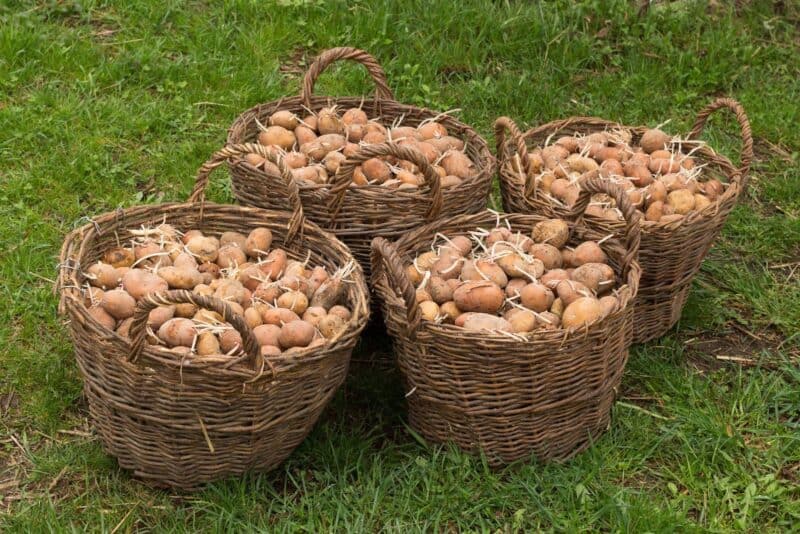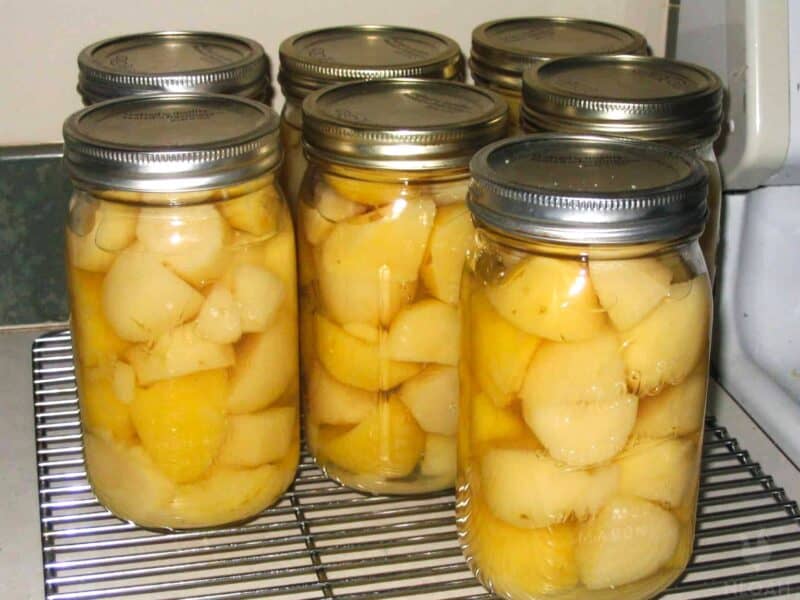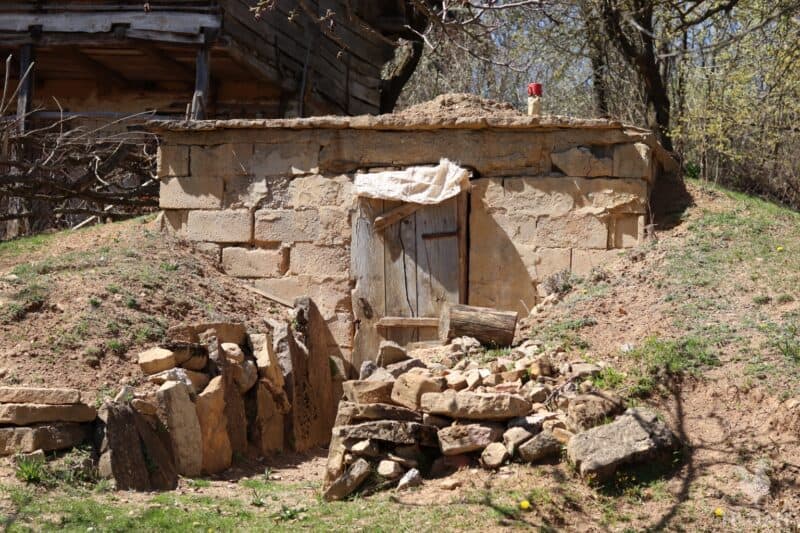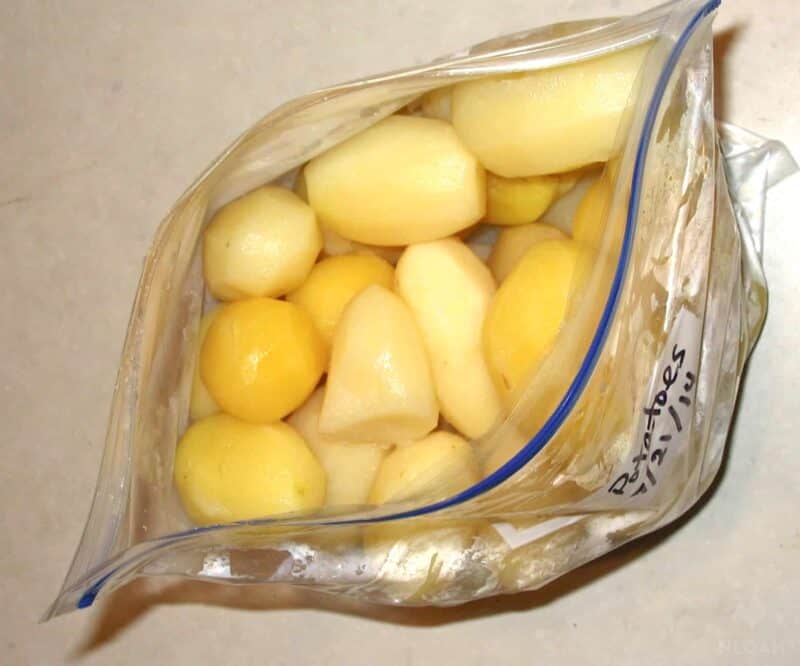Potatoes have been a staple crop for centuries. Thankfully, they are an inexpensive and easy to grow vegetables that consistently produces a bumper crop. But, storing the potatoes so they do not rot and are both good and safe to eat for the winter and spring (until a new crop can be harvested) is a different story.

Storing potatoes seems like a harvest preservation chore that will take up a lot of space, but that is not necessarily so.
Small town, suburban, or small acreage homesteaders who enjoyed a robust potato harvest do not need a large root cellar to keep prevent the crop from rotting.
Electricity is not required for proper storage of potatoes – which is great news for off the grid homesteaders.
This carbohydrate and potassium rich crop can keep for up to 12 months (on average), without the aid of modern utilities – when stored in the right conditions.
Learning how to store potatoes properly can allow you to take full advantage of the versatility of this staple and nutrient-rich traditional garden crop that can be cultivated twice a year in most USDA agricultural zones.
Potatoes are also a vital vegetable to have on hand during an emergency situation when the power goes out. Even if you do not have a fireplace or wood cookstove, you can simply wrap a baked potato in aluminum foil and roast it oven an open fire for a quick and filling meal.
Table of Contents:
Potato Storage Requirements
Because potatoes are a type of vegetable crop known as “tubers” they not only grow but thrive in humid environmental conditions.
A potato is made up of roughly 80% water. When stored in locations that are bright, warm to hot, and not well ventilated they will quickly rot.
Potatoes must always be kept in a dark place regardless of the type of preservation method you choose on your homestead. If harvested potatoes are subjected to light the chlorophyll process will be initiated, they will show signs of wrinkling and, ultimately, rotting.
If potatoes are stored in an environment that is both humid and dark they will rot far quicker because such conditions mimic too closely those needed for this type of vegetable to sprout and grow.
The most important part of potato storage involves getting the level of humidity and light level correct. The traditional recommended temperature for potato preservation is between 55 to 67 degrees F (12 to 20 degrees C).
Some researchers are now recommending that storing potatoes are a lower temperature, like in the refrigerator, will further prevent sprouting and rotting.
Those who subscribe to this line of thought often feel that lower temperature storage may decrease a loss of nutrients in the potatoes, as well as inhibit shrinkage over time.
When potatoes are preserved at 43 to 55 degree F temperatures (6 to 12 Celsius) they are typically thought to prevent the development of “eyes” or sprouting, and then rotting for at least three to five months. This level of heat is higher than the inside of a refrigerator, cellar, or similar unheated storage structure.
The 7 Best Ways To Store Your Potatoes

1. Pressure Canning
Canning potatoes can keep them fresh and safe to eat for approximately two years – if not longer, in my personal experience. The tubers should be pressure canned instead of water bath canned. They must also be blanched during the home canning process, to safely preserve them.
If potatoes are not blanched then all you will be left holding is a Mason jar of nasty white mushy goo. To can potatoes they must be washed, cut into chunks no larger than half of an inch, or diced.
The blanching process can discolor potatoes, especially if they were stored at temperatures lower than 45 degrees F (7 degrees Celsius). The discoloration typically causes dark spots on the potatoes but does not really alter the taste or make them unsafe to eat.
Next, it is time to blanch the potatoes. Simply put the potato chunks or diced pieces into a pot and boil until they are only just cooked. If the potatoes are boiled for too long, they will not be in a proper condition for canning – only mashing or frying and eating.
Once the chunks are boiled, strain away the water, and place the still hot pieces into a glass canning jar. Place another pot of clean water on, and bring it to a rolling boil. I recommend using quart jars, and throwing in roughly 1 teaspoon of salt.
Now, fill each canning jar three fourths of the way up with potato chunks followed by carefully pouring in the boiled water up to the standard canning headspace level of the jar. Never skip the second pot of boiling water step and use the water in which the potatoes were boiled.
Pressure can the potatoes being preserved under 10 pounds of pressure. Quart jars should be pressure canned for 40 minutes, and pint jars for 35 minutes.
The user’s manual that came with your pressure canner should outline the proper pressure and timing for various types of vegetables, including potatoes. Also, I highly encourage you to check out Kendra’s article here on how to do this right, and check out her step-by-step photos.
It typically takes 20 pounds of potatoes to fill 7 quart Mason jars. It is best to use small to medium size potatoes for canning. Some folks can their potatoes whole instead of chunked, which can increase cooking time. If canning whole potatoes, make sure not to use any that are wider than two inches in diameter.
2. Root Cellar
If you have or plan to build a root cellar on your homestead, this is an ideal place to place potatoes for long-term preservation. The time and money it takes to construct a root cellar is well worth the effort if you grow the bulk of what your family eats for the year.

Potatoes placed in a root cellar typically have far greater longevity than those preserved in any other manner – without a reduction in either nutrients or overall quality of the potatoes.
It is possible to keep potatoes for more than a single year when placed inside of a well-constructed root cellar.
If the potatoes start to feel mushy or if they grow eyes, remove them from the storage bin immediately. These potatoes can generally still be used if prepared promptly, but leaving them next to others in the root cellar can cause any rotting on one potato to spread to those next to it.
Never forget to carefully inspect each potato before you put it in a bin inside of a root cellar. If you place even one damaged or bruised potato into the bin, the rot will also spread to those in perfect condition next to it, as well.
If you do not currently have a root cellar, an unheated and unfinished basement can often mimic the conditions inside of a root cellar. But, you must find a spot in the basement that protects the canned potatoes from both moisture and light, to provide environmental conditions that equal those found in root cellars.
It is best to never wash off the dirt on the tubers after taking them from the garden and before storing them. The dirt can help protect the potatoes from both light and moisture, increasing longevity.
To enhance the proper preservation conditions further, lay the potatoes onto pieces of black and white newspaper in temperatures ranging from 50 to 60 degrees F (10 to 15 Celsius) for two weeks – covering them with another piece of the same type of newspaper.
At the end of the time period, remove the potatoes from the newspaper, and inspect them for signs of bruising and rot. If any of them were nearing rot or had excess moisture that would have led to rotting, the newspaper will help draw it out and prevent you from exposing an entire bin to damaged tubers.
3. Perforated Plastic Sacks
Use a grocery store trick for keeping potatoes fresh and ready to eat. Place them inside of a vented plastic bag or even a mesh bag to preserve them from spoiling for up to six months.
The vents or perforations in the plastic bag will help prevent any shrinkage or rotting – or the development of eyes. When stored in an environment that is between 55 to 57 degrees F (12-13 C), the perforated plastic sacks should also help prevent the potatoes from becoming mushy for a far longer time than being stored in a typical wood indoor potato bin.
The humidity in the storage environment should be kept stable and at 67 percent.
Never close the end of the plastic sack tightly or the humidity levels will increase too much.
4. Dehydrating Potatoes
Dehydrating potatoes is my favorite way to preserve them because it extends their longevity far longer than any other method I have tried. You can dehydrate potatoes with their peels either on or off.
To dehydrate the tubers, wash and slice them to approximately one-eighth of an inch thick. Using a mandolin will vastly speed up the process, and produce more evenly sliced potatoes – especially if dehydrating a large batch all at once.
Drying uniformed slices is essential to proper dehydration. When the slices vary in thickness they will not dry evenly, and increase the potential for a partially dried potatoes slices being placed in a bag or jar and causing all of the contents to rot.
Place just one layer of potato slices in each tray of your dehydrating machine. Always leave space for air flow between every single slice – the potatoes should never touch each other.
Dehydrate the tubers on the vegetable setting or at approximately 130 to 135 degrees F (54 to 57 C). The texture should feel dry and crisp to the point they break in half when bent. In a moderately-priced dehydrating machine expect it to take roughly 10 hours to fully process five full trays of potatoes.
After removing the dried potatoes from the dehydrator trays, immediately put them in a glass canning jar or vacuum sealer bag. If your vacuum sealer machine has an attachment for Mason jar, I highly recommend using it to remove any excess air from the jar, as well.
To conserve space, you can also run the dried potato slices through a food processor or blender to powder them, before storing in the same manner as noted above.
Two tablespoons of powdered potato flakes is approximately equal to one ounce of a potato. There is no need to separately reconstitute powdered potatoes if you are putting them in a recipe that will include liquid. They can be used in the same manner as store-bought instant potato flakes.
5. Cardboard Box or Paper Sack Method
You can store harvested tubers in a cardboard box or a brown paper bag to preserve them. When the potatoes are placed in such an environment the ethylene gas they contain will help prevent rotting or the growing of eyes. This same technique can be used to ripen green tomatoes.
The ethylene gas produces a natural preservation effect on the potatoes. The potatoes going into the sack of cardboard box must be thoroughly inspected for signs or bruising, mushiness, rotting, or other damage. If one potato is going bad, it can negatively impact the rest of the tubers and cause them to begin to decay as well.
Close the paper sack or the flaps on the cardboard box, but do not overcrowd the potatoes to allow for ventilation. Never stack boxes on top of each other or seal the bag entirely; doing so will increase the humidity levels too much, and cause rotting.

6. Freezing
This method of potato preservation works quite well, as long as the power does not go out, or your generator runs out of fuel. Frozen potatoes should remain shelf stable for 12 months. If you have an off grid ice house on your homestead, the potatoes can be frozen inside it, as well.
Before freezing the potatoes, they have to be both washed and peeled. Next, either cube the cleaned potatoes or cut them into chunks no larger than one inch.
Just like with canning, the potatoes must be blanched before they are frozen. Potatoes that are not blanched before they are placed in the freezer will go into a “cold induced sweetening” phase. When this condition occurs, the incredibly large amount of starch the potatoes contain will convert into sugar.
Once sweetened, if the potatoes are cooked in a hot temperature environment, like in a casserole dish inside of the oven or in a skillet, it is quite possible that dangerous carcinogens could be released.
When a raw potato is placed in an environment that is too cold or freezing it will turn brown and then crystals will grow on the tuber that will cause cell wall structures to decay.
The blanched potatoes must be completely cool before being placed in a Ziploc bag, and in the freezer. Placing room temperature or fairly cool to the touch potatoes in an airtight bag or container in the freezer will cause the entire contents to turn to mush or rot.
If you have a vacuum sealer machine, I highly recommend using the bags that come with them instead of grocery store freezer bags.
It is best to store the potatoes in quart or pint bags instead of gallon Ziploc bags, unless you have the need to make such a large batch of potatoes all at one time. Once the bag of potatoes is thawed, the remaining contents will need to be refrigerated and used within just a few days.
Once this happens, the potatoes turn to mush, and are no longer fit to eat. Only after the raw potatoes are blanched or par-broiled, are the browning enzymes that cause discoloration and rotting to occur deactivated.
Check out our article on freezing potatoes step by step here.
7. Cold Hole
The holes potatoes are planted in underground are similar to those found inside of a cave. When you recreate such an environment with harvested potatoes, they can be preserved for extended periods of time. This style of potato storage is commonly referred to as “cold hole” preservation.
People have used cold holes to preserve a potato harvest for centuries. You can store other root crops in cold holes to preserve them, as well. Typically, the hold is lined on the bottom and on the sides with smooth rocks to create the proper cave-like environment.
Never put the potatoes inside any type of sack, box, or container before placing them in a cold hole. Doing so will increase the humidity level too intensely and cause the potatoes to rot.
The potatoes should be buried 3 feet deep in a hole to protect them from freezing and rain water accumulation. Tubers stored in this manner often develop tough skins that make them poor choices to be baked when they are dug up later.
You might want to sink a trash can or other container into the ground if you have moles or other underground varmints that might steal your spuds.
Make sure to dig the hole two feet deeper than the depth at which the ground freezes, then cover your potatoes with straw.
Top the hole off with a mound of dirt, then keep water from seeping in by placing a sheet of plastic or metal overtop it all.
Potato Storage Tips
- Potatoes like it best between 40 F and 50 F (4 C to 10 C). Do not store them in the fridge.
- Do not store potatoes near apples or onions; they make the potatoes sprout faster.
- Do not allow your potatoes to freeze unless you have pre-cooked them beforehand. Frozen potatoes are safe for animals to eat, but are no good for people.
Conclusion
All of these potato preservation methods work quite well when the directions for each are keenly followed. The time it takes to preserve large batches of potatoes during the busy days after a harvest will likely be a key deciding factor in how you choose to preserve your them.
Pressure canning is the quickest way to process and preserve large quantities of potatoes, in my experience.
I often dehydrate potatoes more (now that I have five dehydrator machines) than I used to when I had only one machine.
Being able to dry multiple batches of potatoes at once vastly speeds up the process when preserving large batches.


Tara lives on a 56 acres farm in the Appalachian Mountains, where she faces homesteading and farming challenges every single day, raising chickens, goats, horses, and tons of vegetables. She’s an expert in all sorts of homesteading skills such as hide tanning, doll making, tree tapping, and many more.
